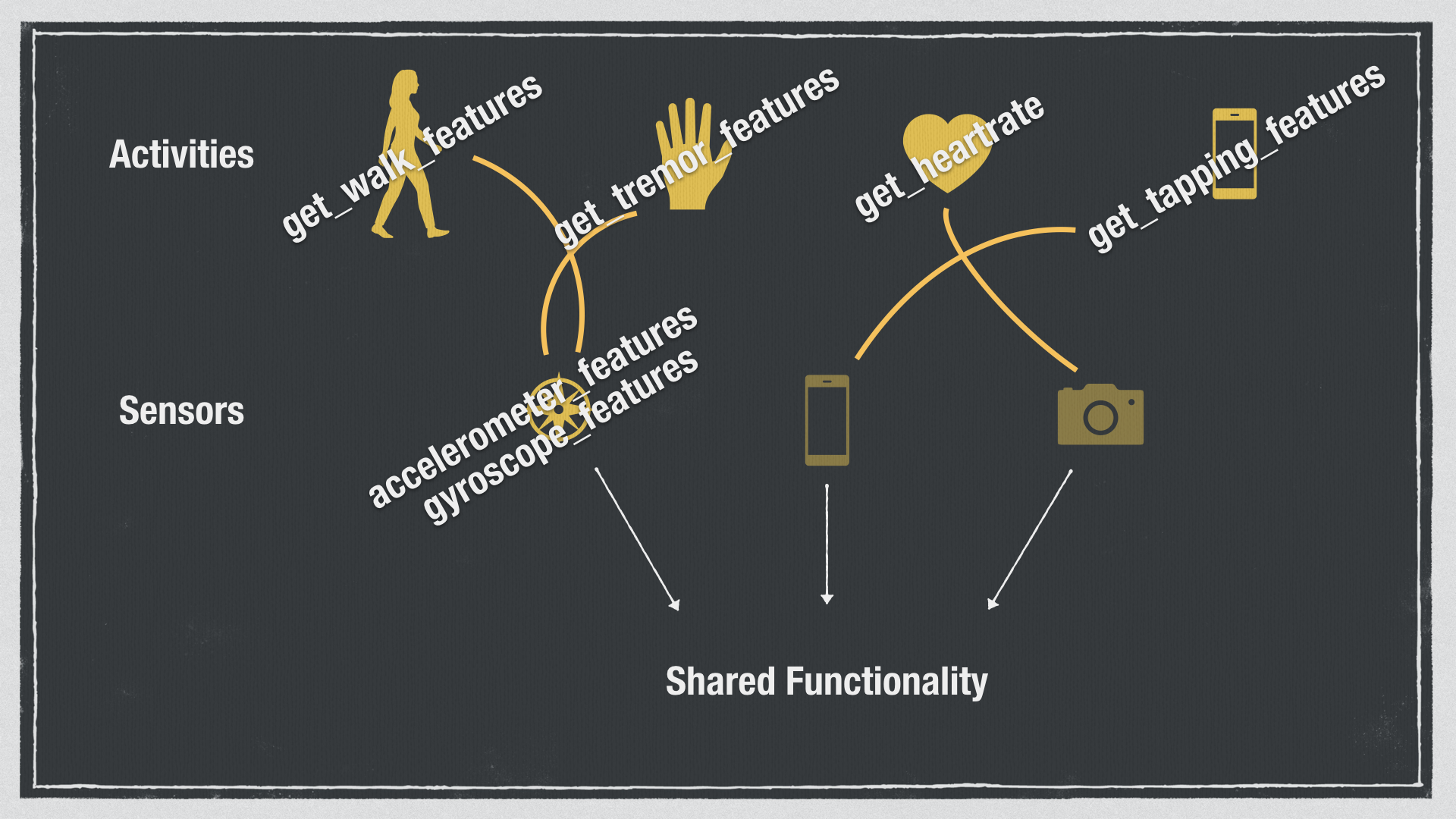An R package for extracting features from mobile and wearable sensor data.
mhealthtools processes raw data from various mobile and wearable sensors — such as accelerometer, gyroscope, touch screen, and camera — and outputs interpretable feature sets. Included with the package are feature extraction functions designed for activities used in mHealth applications developed by Sage Bionetworks, as well as general use functions that work with any activity using mobile and wearable sensors.
Install the mhealthtools package using devtools:
devtools::install_github("Sage-Bionetworks/mhealthtools")
Install the package with the vignettes:
devtools::install_github("Sage-Bionetworks/mhealthtools", build_vignettes = TRUE, dependencies = TRUE)
Alternatively, you can use this Docker image — based on rocker/tidyverse:latest — which comes with mhealthtools preinstalled.
A common issue on Debian-based systems when installing the seewave dependency is to be missing the system dependencies libfftw3 and libsndfile1. In a shell, run:
$ apt install libfftw3-3 libfftw3-dev libsndfile1 libsndfile1-dev
to install these system dependencies, then retry the above devtools command.
If you are still having issues installing seewave, it may be necessary to also install the rgl library.
$ apt install r-cran-rgl
If not using a Debian-based system, please check for equivalent dependencies in your distro's package repository.
See the seewave installation page for more info.
There are two broad types of modules included with mhealthtools: activity-level and sensor-level modules.
Activity-level modules, like get_tremor_features and get_walk_features, extract features from every sensor involved in that activity. For example, the two previously mentioned functions both return accelerometer and gyroscope features. These functions are useful for their convenience — we can share parameters since the feature extraction process is nearly identical between accelerometer and gyroscope sensors.
get_tremor_features(accelerometer_data, gyroscope_data)
Underneath the hood of activity-level modules operate sensor-level modules. These modules are designed to extract features from a single sensor. If you were to design a new activity, you could borrow the already implemented sensor-level modules to extract its features.
gyroscope_features(gyroscope_data)
Both activity-level and sensor-level modules allow you to include additional steps in the feature extraction pipeline by passing additional arguments to their respective functions. If passing only the input data, a default set of features will be extracted from the raw sensor measurements. But suppose you are working with accelerometer data and would like to detrend, filter frequencies from, and window the axial measurements, then compute measurements for jerk, velocity and displacement — all before extracting features from each measurement.
accelerometer_features(
sensor_data = accelerometer_data,
detrend = TRUE,
frequency_filter = c(1, 25),
window_length = 256, # measured in number of samples
window_overlap = 0.2,
derived_kinematics = TRUE)
If you omit the funs and models arguments, a default set of features will be computed. But you can, of course, provide your own feature extraction functions.
my_features <- function(x) {
data.frame(
"mean" = mean(x),
"median" = median(x),
"sd" = sd(x))
}
gyroscope_features(
sensor_data = gyroscope_data,
window_length = 256,
window_overlap = 0.2,
funs = my_features)
At the moment, only accelerometer and gyroscope sensors have this powerful processing pipeline implemented. For sensors such as screen and camera, it is more complicated to provide a useful set of preprocessing and feature extraction functions that generalize well to varied activities. We provide two activity-level functions for these sensors (get_heartrate and get_tapping_features), but no functionality at the sensor level of granularity — at least not yet.
For more information on how to augment mhealthtools with your own functionality — including not just your own feature extraction functions, but also your own preprocessing/data-cleaning steps — we highly recommend reading the vignettes.
If you have questions about using this package, there are a number of readily available resources. Vignettes are provided which demonstrate typical package use, how to extend the functionality of the provided functions, and feature definitions. Follow the installation instructions about installing the package with vignettes above and access the vignettes from within an R session:
browseVignettes("mhealthtools")
If you have questions about package usage that are not covered in the function docstrings or the vignettes, we encourage you to file an issue. If your question is not appropriate to be posted as a public issue, you may privately contact the package authors ([aut]) listed below.
To report an issue, please file a GitHub issue with the main repo.
If you would like to contribute to mhealthtools, please file an issue so that we can establish a statement of need, avoid redundant work, and track progress on your contribution. Once an issue has been filed and we've identified how to best orient your contribution with package development as a whole, fork the main repo, branch off a feature branch from develop, commit and push your changes to your fork and submit a pull request for Sage-Bionetworks/mhealthtools:develop.
- Phil Snyder phil.snyder@sagebase.org [aut, cre]
- Meghasyam Tummalacherla meghasyam@sagebase.org [aut, ctb]
- Thanneer Perumal thanneer.perumal@sagebase.org [aut]
- Abhishek Pratap apratap@sagebase.org [ctb]
- Elias Chaibub Neto elias.chaibub.neto@sagebase.org [ctb]
Apache License Version 2.0, January 2004
